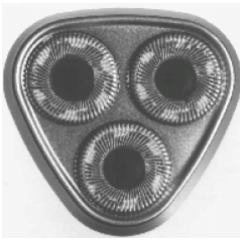Koninklijke Philips Electronics Ltd. v. Remington Consumers Products Ltd.
Koninklijke Philips Electronics Ltd. v. Remington Consumers Products Ltd.
C-299/99
European Court of Justice
Brief Facts:
Plaintiff was the registered proprietor of the following shape mark:

In 1966, Philips developed a new type of three headed rotary electric shaver. The three headed shape was registered as a trade mark in the year 1985. In 1995, Defendant started to sell a shaver with three rotating heads shaped similarly to the registered trade mark. Plaintiff filed a suit for infringement of trade mark and Defendant filed a revocation for removal of trade mark.
The High Court of Justice of England and Wales, Chancery Division, ordered revocation on the ground that the mark was:
- incapable of distinguishing the goods of Plaintiff from others;
- was devoid of distinctive character;
- mark consisted exclusively of a sign which served in trade to designate the intended purpose of the goods; and
- was necessary to obtain a technical result
On appeal of the Plaintiff, the Court of Appeal referred decided to stay proceedings and referred certain questions to the European Court of Justice for determination.
The European Court of Justice held that:
- Where a trader has been the only supplier of particular goods to the market, extensive use of a sign which consists of the shape of those goods may be sufficient to give the sign a distinctive character in circumstances where, as a result of that use, a substantial proportion of the relevant class of persons associates that shape with that trader
- It is for the national court to verify that the circumstances in which the requirement under that provision is satisfied are shown to exist on the basis of specific and reliable data.
- Signs which consist exclusively of the shape which results from the nature of the goods themselves, or the shape of the goods which is necessary to obtain a technical result, or the shape which gives substantial value to the goods cannot be registered or if registered are liable to be declared invalid.
- Where the essential functional characteristics of the shape of a product are attributable solely to the technical result, Article 3(1)(e), second indent, precludes registration of a sign consisting of that shape, even if that technical result can be achieved by other shapes.
In the present case, the shape was held to be functional.

